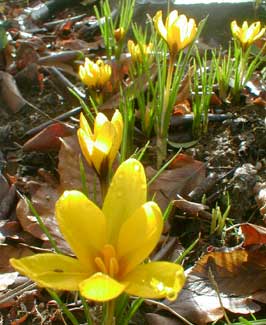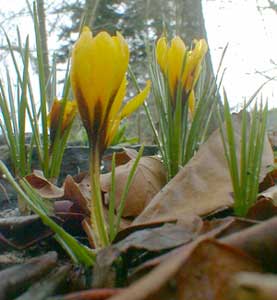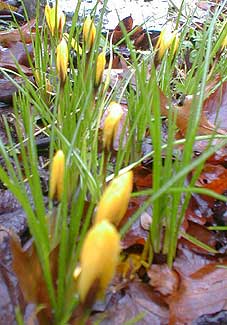
Korolkov's 'Mountain Glory' Crocus;
or, 'Mountain Glory' Celandine Crocus
"The crocus hoards the sunset gold."
-Florence Earle Coates,
1850-1927
1850-1927
Various cultivars of Crocus korolkowii show different stripes or feathering on the outer petals, ranging from purple to brown or grey against bright yellow. 'Mountain Glory' has a maroon flame on each outer petal, pure yellow on the inside.
It is early-blooming. In our garden its first year, its buds were opening by mid-January, though in some places they will wait until early February. Their second year, they bloomed in December, during a warmish winter with unusually heavy & persistent rainfall; & due to the hard rains, they were beaten down as prematurely as they bloomed.
 Only C. ancyrensis reliably blooms sooner (often by scant days) than our C. korolkowii varieties, the two species seeming to be in a race. The year that 'Mountain Glory' arrived in December, C. ancyrensis was in equally full bud, but were less inclined to open because of perpetually overcast days. 'Mountain Glory' was less persnickety about needing a very sunny day, so opened & got weather-beaten, whereas the similarly-yellow C. ancyrensis was still in fat bloom three weeks into January opening only on the sunniest days & protecting themselves during the rain.
Only C. ancyrensis reliably blooms sooner (often by scant days) than our C. korolkowii varieties, the two species seeming to be in a race. The year that 'Mountain Glory' arrived in December, C. ancyrensis was in equally full bud, but were less inclined to open because of perpetually overcast days. 'Mountain Glory' was less persnickety about needing a very sunny day, so opened & got weather-beaten, whereas the similarly-yellow C. ancyrensis was still in fat bloom three weeks into January opening only on the sunniest days & protecting themselves during the rain.'Mountain Glory' is one of the most cold-hardy crocuses that will naturalize quite far north. The corms are large for such a small crocus, more than twice the size of C. chrysanthus corms.
 Other varieties include 'Yellow Tiger' which is tiger-striped, while 'Golden Nugget' & 'Kiss of Spring' are predominantly yellow with only whispers of purple markings. 'Lucky Number' has a maroon-brown throat similar to the cultivar called 'Dark Throat.' 'Agalik,' named for the valley in Uzbekistan where it was found, has maroon blotches, as does 'Spring Cocktail' (but I wonder if these are two names for one variety). Even if some of the varieties look awfully similar, they tend to begin blooming in different weeks.
Other varieties include 'Yellow Tiger' which is tiger-striped, while 'Golden Nugget' & 'Kiss of Spring' are predominantly yellow with only whispers of purple markings. 'Lucky Number' has a maroon-brown throat similar to the cultivar called 'Dark Throat.' 'Agalik,' named for the valley in Uzbekistan where it was found, has maroon blotches, as does 'Spring Cocktail' (but I wonder if these are two names for one variety). Even if some of the varieties look awfully similar, they tend to begin blooming in different weeks.All these cultivars are very sturdy in the garden, but unlike C. chrysanthus cultivars, most C. korokowii varieties are not terribly distinct one cultivar to the next, being in the main yellow. But a variety called 'Snow Leopard' erupted in cultivation & that one's predominantly white, with big bright yellow anthers.
Since conditions have to be fairly perfect (bright overcast to sunny, & no heavy rain to knock them down) it's nice to plant every variety that can be obtained, so that which days or weeks are ideal will find one or another C. korolkowii showing itself to ideal effect. This is true for just about all crocuses really; not all will have a perfect showing every year depending on storm patterns, & each year will find differing species or varieties in good time with the weather.
The species is native to Pakistan, Afghanistan, Uzbekistan, Tadjikistan, & northward through Russia to the Kara Tau mountains. It is named for General N. J. Korolkov who collected plants in Central Asia in the 1870s for the botanical garden in St Petersburg. Korolkov also has an iris, arum, honeysuckle & a few other plants named for him.
Sometimes called the Celandine Crocus, because it is the same color as Lesser Celandine & the Celendine Poppy. The name Celendine has come to mean "yellow;" but the word in actuality alludes to a swallow, & very early bloomers were so-named because they were first to flower in the year, as swallows are among the first birds to return before winter has even ended. The reason so many of the earliest-blooming crocuses plus buttercup-family celendines are bright yellow is because they're competing for the same early-season pollinators, which are most attracted to yellow.